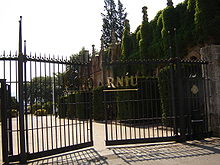Codorníu

Codorníu is the world's largest producer of sparkling wine fermented in the bottle , made using the traditional champagne method ( méthode traditionnelle ). The company was founded in Catalonia in 1551 . 60 million bottles are produced annually. Spanish sparkling wine from the Catalonia region is called cava .
history
The Codorníu family's wine business dates back to the mid-16th century. A document from this period shows that the family owned several machines and devices for making wine . Anna Codorníu married Miquel Raventós in 1659 and both families, each with a long winemaking tradition, were united. In 1872 Josep Raventós produced cava for the first time in Spain using the traditional method, establishing a completely new industry in the Alt Penedès region .
The Codorníu winery in Sant Sadurní d'Anoia was built by Josep Puig i Cadafalch on behalf of Manuel Raventós between 1895 and 1915. At the time, Codorníu was producing just 100,000 bottles of cava a year and the size of the new structure seemed excessive. The location of the winery, some distance from the road and railway line, was unusual for the time. However, Manuel Raventós was convinced that the family winery should be as close as possible to the vineyards, because he knew that such proximity would be the key to improving the quality of the wines. As an example of the industrial architecture of Modernism , the winery is now a listed building.
Codorníu still controls the entire production process of all cavas from viticulture to the finished product.
expansion
Today Codorníu is the owner of many brand names that represent growing areas of over 3000 hectares in Spain and America. These are: Masia Bach ( Catalunya ), Légaris ( Ribera del Duero ) Scala Dei ( Priorat ), Abadia de Poblet ( Conca de Barberà ), Bodegas Bilbaínas ( Rioja ), Raimat ( Costers del Segre ), Nuviana ( Valle del Cinca ), Séptima ( Mendoza ) and Artesa ( Napa Valley , USA).
The growth of the company can be divided into several phases. The first step was the takeover of the sparkling wine company Bach, which had existed since 1914, in the 1940s. The Cava Rondel was born from this expansion . In the 1970s, the policy was to include the most important Spanish wine regions in the product range. Noles volens, this was a move away from an assortment consisting exclusively of sparkling wines towards still wines . The portfolio went international in the 1990s with the Californian Artesa Winery in Napa Valley. In 1999 the move to Argentina finally followed .
See also
literature
- Jancis Robinson (Ed.): The Oxford Wine Lexicon . Hallwag, Gräfe and Unzer, Munich 2006, ISBN 3-8338-0691-5 .
- Jan Read: Spain's Wines 2005/06 . 7th edition, Hallwag Verlag Munich, ISBN 3-7742-6962-9 .
- John Radford: The New Spain . 1st edition, Mitchell Beazley, ISBN 1-84000-928-4 .
- Jeremy Watson: The New & Classical wines of Spain . 1st edition, Montagud Editores Barcelona, ISBN 84-7212-087-2 .
Individual evidence
- ↑ Codorníu , Hispavinus
- ↑ Our History History of Codorníu Raventós, Birth of a Group .


